|
20th July 2015, Nant Alyn
We have only visited here in 2013, so time perhaps for another look. First off, no signs of Birds-nest Orchids, but only a single specimen had been seen. This time a few Common Spotted Orchids were noted, raising the species numbers to 3.
But the real reason to visit is the Green-flowered Helleborines. It is not a large colony and does not seem to be increasing, though a number of younger flower spike-less plants were found along the main path. The main area up a footpath and under bushes numbered just 12 plants, and all were still in tight bud. This is despite those seen earlier at Marford starting to open; the sites are only 15 miles apart and both are likely to be E. phyllanthes var pendula.
23rd July 2015, Leckhampton Hill
Another short trip to south Gloucestershire, this time a month later and armed with a bit more information, in order to catch what was missed last time - hopefully.
No climb to the top today. The interest lies in the helleborines fringing the quarry car park. I took more photos of the well past it Cephalanthera to help clarify the species. However, I have come away just as uncertain. One differentiator between Sword-leaved and White Helleborines is supposed to be the ovaries; are they twisted or not. These plants show both features.
Unfortunately the main Epipactis colony had still not got closer to flowering. However, the big discovery was made nearby with an Epipactis totally devoid of chlorophyll! The whole plant was a pale buttery yellow, but like the others still in bud. The leaves were quite damaged but overall it looked healthy and fairly tall. I had put down the helleborines here as Narrow-lipped last visit and jumped onto that as this specimen's species; perhaps too hastily. Sharing the images has others with more experience than me saying that it's an achlorophyllous Broad-leaved Helleborine. If it is an NLH, then the only other record is 85 years old and in Surrey, but if BLH it is merely "extremely rare". Admittedly the other plants nearby are quite Broad-leaved in appearance, but note the leaf arrangement is opposite sides of the stem and not spirally. This argument is easily countered with such features being pointers rather than diagnostic. However, I will still put some faith in the lack of any pink colouration. The variety is lacking chlorophyll, not anthocyanins, so I would have thought that the base of the stem of the ovaries would show some pink colouration if it was Broad-leaved. Again though, this observation is just a pointer. So what about the photos showing that the ovaries are not twisted around like a BLH? Hopefully images of this plant in flower will be posted up and it is identifiable. This abnormality is similar to that which occurs with the Violet Helleborine var rosea. Evidently the Epicpactis genus has both the genetic fault somewhere in its DNA, and the capability to extract all its nutrients from the mycorhizal fungus that it associates with. One big question still remains. How did I not see this in June. The only explanation was that butter coloured plants were not on my radar.
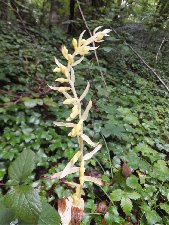 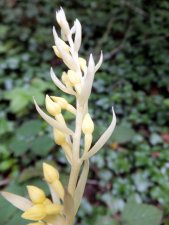 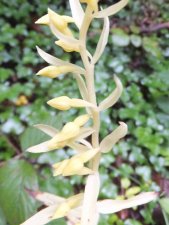
23rd July 2015, Barrow Wake
I have two reasons to revisit here. The first is to see Musk Orchids. I was quite disappointed to see no trace of an orchid, even if they were still in bud, having been told `hundreds fore and aft'. Since the end of June Musks have been reported flowering and I have the location down to a few feet. Sure enough, they are duly discovered. While some undoubted have gone over there are still plenty in peak condition. And it is abundantly clear why no trace was found in June - they are exceedingly small; smaller than I imagined; just 4cm or so tall, with leaves hidden and disguised within the grass. A budding spike would not be noticed in the grass, especially when one looked for something twice as tall at least. And they do smell of honey rather than musk.
The other reason is that I got further information on a Broad-leaved Helleborine described as a `neerlandica type'. This surprised me as this species/form/variety (or whatever depending on your point of view) is supposed to grow in the dunes in the North Sea coast from Belgium to Denmark , though some have been reported from Kenfig, which is probably a similar habitat; which Barrow Wake is not. That said I suspect a degree of scepticism as it is referred to as `neerlandica type'. Anyway, these are said to be shorter stockier plants, with dull purple flowers densely packed on the spike, with deeper green erect leaves sheathing the base of the stem. A Broad-leaved Helleborine was found at the right spot. In fact there were two, but they were not in flower, and the neerlandica features are not all there or obvious. More examples of this species were found behind the carpark in a dip (which may explain why we didn't see them in June). These do not have neerlandica features, but are notable for the huge bracts, several times the length of the ovaries even close to the tip of the spike.
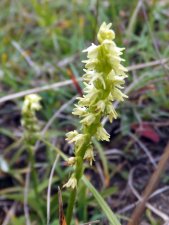 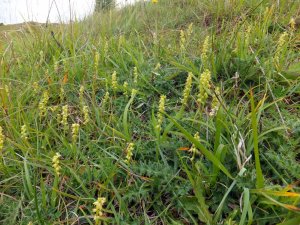
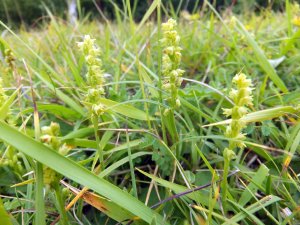 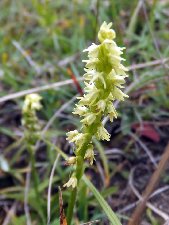
23rd July 2015, near Birdlip
This is a strip of deciduous woodland bordering the road to Stroud, and I have been given two locations for Narrow-lipped Helleborines growing along the path at the back, adjoining the farmland, and about 300 yards apart. Both are successes, though only a handful of flowers at each. The flowers are just opening at the furthest group but still in bud at the other. A check-up two days later shows a few more flowers out. Flash photography proved helpful with some of the shots. Note the unusual shaping of the lip on a couple of flowers. Is this a newly opened artefact?
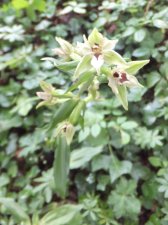 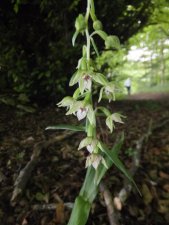 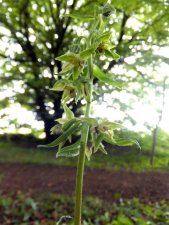 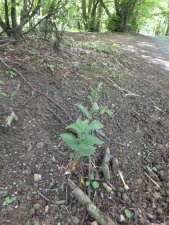
23rd July 2015, Painswick Hill
Again another repeat visit to a site to look for Musk Orchids, again armed with new information. This time though the failure last time was due to being in quite the wrong place. This colony was much smaller than the ones at Barrow Wake, but may have suffered from being virtually below a bench, and being trodden on - so easy to do. I have noted some similarities about the two sites. Both are on well grazed hillsides with similar soil and geology. The both face south west, and the orchids are confined to a band across the slope, making me think above is too dry, and below too damp. A Goldilocks effect? And more uncomfortably, they share the soil with some large, flat, and very prickly thistles. This is one of those species where contact with the ground is unavoidable when trying to photograph them.
23rd July 2015, Buckholt Woods
I have some 8-digit OS grid references for Narrow-lipped helleborines in this ancient beech wood, part of the Cotswolds Woods NNR. How can I go wrong? Firstly I can plot approximations for those GRs on my map and use a satellite image of the woods, but actually getting to precise spots in such a wood is nigh impossible without a GPS device that provides grid references of my position. I really need explicit directions. Despite this we do find some NLH, but either without flower spikes, or having only a few flowers still in bud.
The real prize here, though, was the Birds-nest Orchids. We find one solitary specimen then 50+. This is a dark wood, and they are not easy to see at the best of times. There are large clumps, and some in what looks like a `fairy ring'. They have all gone over of course, and are setting seed, but still great to see. The flash photography required ensures that they appear greyish, rather than their natural brown tones, but it does highlight them against the background instead of them merging with it.
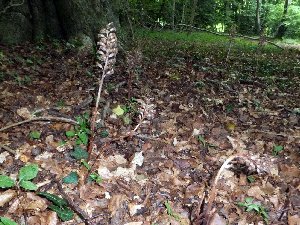 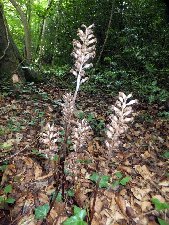
27th July 2015, Coalbrookdale
Though it's a bit early I cannot resist a visit here, especially as a bit of research has revealed two more easily accessible grid references to check out for Violet Helleborines. The roadside site is rather poor this year, with only five spikes in one spot seen. This compares with 20 seen in 2013. The poor show could be the lack of rainfall in the summer. None are close to open flowers.
The new sites are on the opposite side of the dale, on footpaths through the woods. A total of 12 spikes, again not yet in flower, were found in both areas. Along the main path 5 are found growing sparsely along the `downside'. The others are on a side path, and all grow on the `upside'. Again, an orchid species is showing a `goldilocks' effect. These latter plants are more impressive. There is a double spike (though one had been broken down) and a magnificent specimen growing to 80cm in height and sporting 60 flower buds. Another, on reviewing the photos, seems to show var rosea characteristics. However, I am sure that this is a photography artifact. A repeat visit is indicated on both these plants.
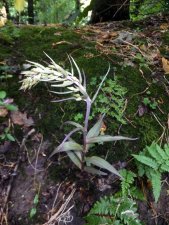 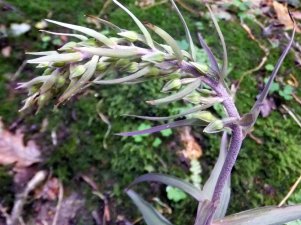 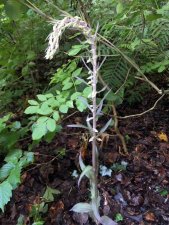
31st July 2015 Alyn Waters Country Park
To round off July we return to the three most local helleborine sites. At Alyn Waters I want to refind the plants which I suspected were Broad-leaved Helleborines two weeks ago - but I have problem recalling exactly where they were; perhaps I am mistaken. Only Dune Helleborines close to going over, and Green-flowered Helleborines predominate. A nice bunch of over 50 GFH is found however, and I am surprised I haven't spotted these before. These are almost certainly pendula.
Also I spot 8 more Marsh Fragrant Orchids which grew near the other single specimen, but are quite hidden from the path behind some bushes.
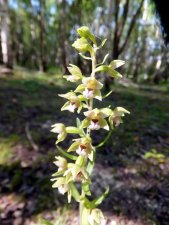 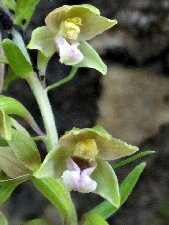
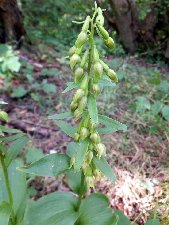 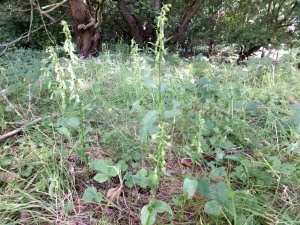 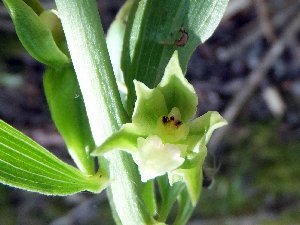
31st July 2015, Marford Quarry
The Green-flowered Helleborines here are also flowering quite nicely, and again must be var pendula
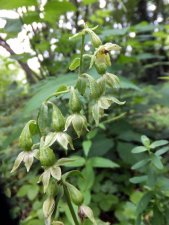 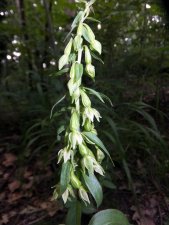 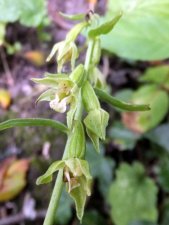
Last year I noticed that one patch of woodland hosting a number of Green-flowered Helleborines seemed to be more open than in previous years. It may have been that a large overhanging branch of a beech tree had been removed. The protection status for this species in Northern Ireland states that it should be given a degree of light as it does not favour the shadier parts of woodland. This reserve must be managed in accordance with these guidelines. The increased numbers of healthy plants this year suggests the policy is working.
31st July 2015, Marford Woods
Again, nothing unusual to report on the Broad-leaved Helleborines here. The viridiflora seen (not by me) in 2012 still does not seem to have reappeared.
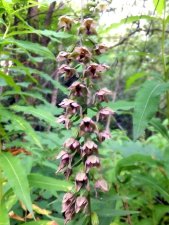 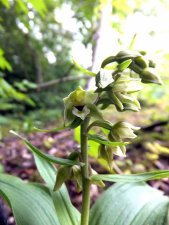
    
|
